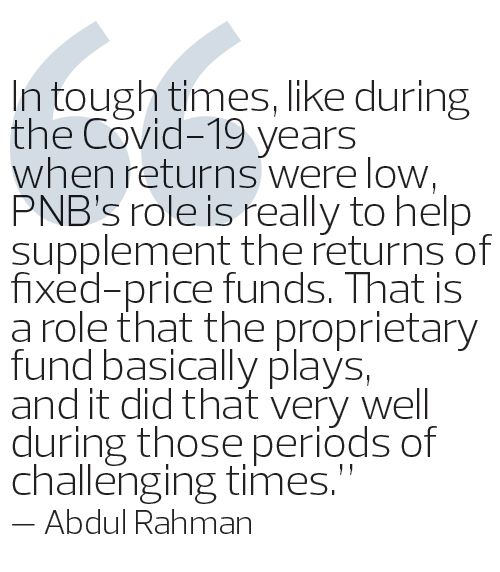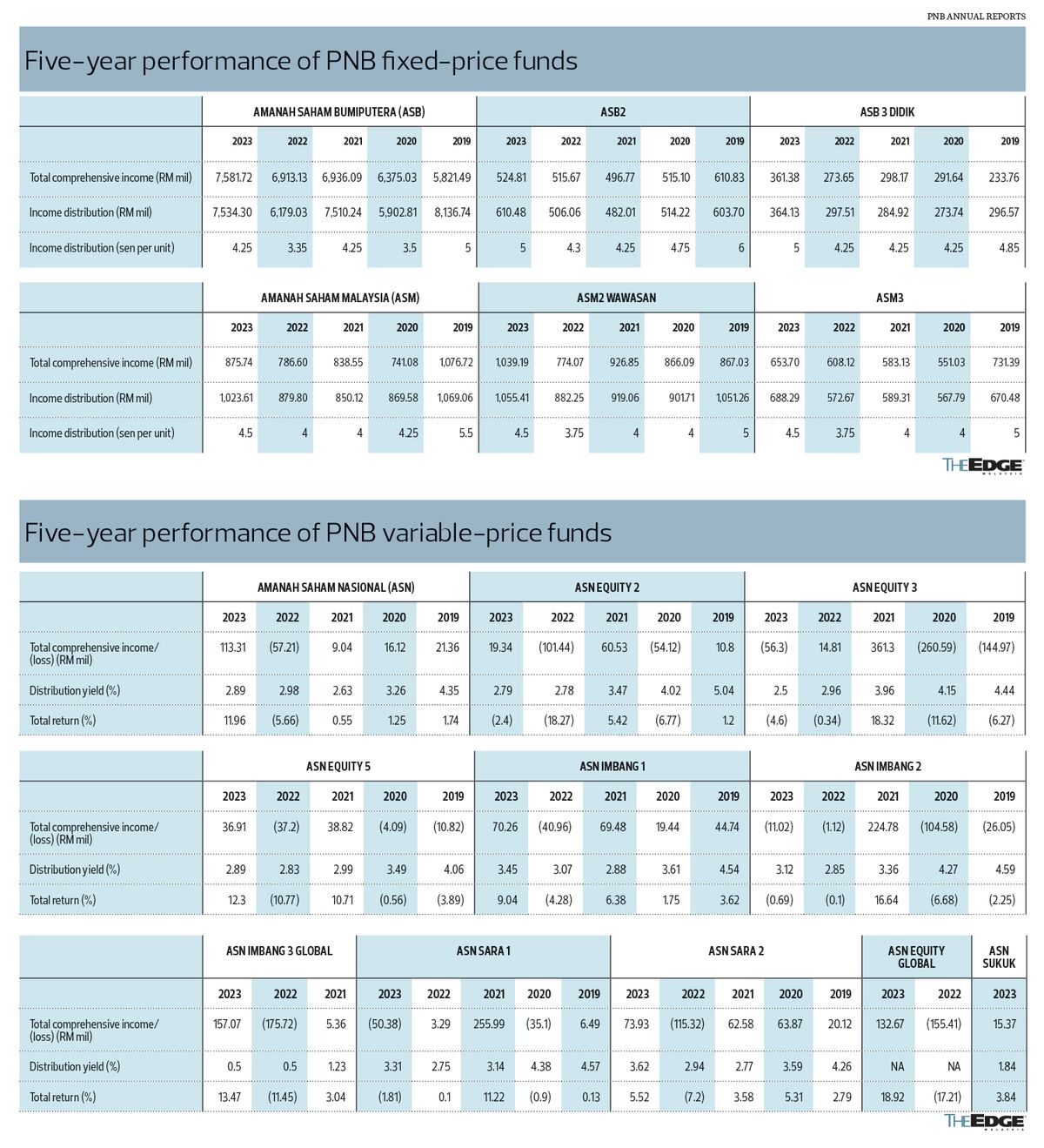
This article first appeared in The Edge Malaysia Weekly on February 17, 2025 - February 23, 2025
PERMODALAN Nasional Bhd (PNB) has long been the investment of choice for bumiputeras in Malaysia, largely due to its healthy and consistent annual returns and income distribution.
Its flagship fund — Amanah Saham Bumiputera (ASB) — has maintained its income distribution above three sen per unit, even during recessions. Given the fixed price of RM1 per unit, ASB’s performance has consistently outpaced the official consumer price index (CPI) every year.
However, a closer look reveals that many PNB funds, including ASB in 2021, distributed more than they earned in a given financial year. ASB distributed RM7.51 billion in 2021 despite only earning RM6.94 billion.
PNB president and group chief executive Datuk Abdul Rahman Ahmad acknowledged this in an exclusive interview with The Edge. He explained that PNB uses its proprietary fund to supplement the returns of fixed-price funds in challenging periods, like during the Covid-19 pandemic.
“This is what not many people are aware of, that part of the reason why PNB has historically been able to deliver what I call enhanced returns is because we have what we call our own proprietary fund,” says Abdul Rahman.
“So, in tough times, like during the Covid-19 years when returns were low, PNB’s role is really to help supplement the returns of fixed-price funds. That is a role that the proprietary fund basically plays, and it did that very well during those periods of challenging times.”
(PNB’s proprietary fund is PNB’s own money, grown from the initial seed contribution from the government at its inception in 1978. Over the years, the income generated has been continually reinvested to build up its reserves until today. The proprietary fund is separate from the unit trust funds, which are funds from the public. The proprietary fund exists solely for the purpose of assisting and facilitating the operations of the unit trust funds.)
In order for the proprietary fund to continue playing its role, PNB needs to generate greater profits from its assets. It also needs to run its operations in a much more efficient manner, he adds.
PNB’s proprietary fund currently stands at more than RM50 billion, according to the asset management firm.
This practice of drawing down from the proprietary fund, however, is not limited to difficult times.
While ASB — launched in 1990 — has been able to distribute income solely from the amount earned in 2022 and 2023, ASB2 distributed RM610.48 million for the financial year ended March 31, 2023 (FY2023) despite making only RM524.8 million. This allowed PNB to declare a distribution of five sen per unit, even though its earnings would have supported only 4.23 sen, given that there were 12.42 billion units of ASB2 in circulation.
The reason for this decision remains unclear.
The same goes for the other fixed-price funds. For the financial year ended June 30, 2023 (FY2023), PNB declared a distribution of five sen per unit for ASB 3 Didik, for a total payout of RM364.13 million, when the fund earned RM361.4 million during the year.
For FY2024, PNB declared an income distribution of 5.25 sen per unit for ASB 3 Didik. That year, it also declared a distribution of 5.5 sen per unit for ASB and 5.25 sen per unit for ASB2.
Amanah Saham Malaysia (ASM), open to all Malaysians aged 18 and above, distributed more than it earned between 2021 and 2023. For the financial year ended March 31, 2021 (FY2021), the fund distributed RM850.12 million, or 4 sen per unit, against RM838.55 million in earnings. FY2022 saw a payout of RM879.8 million, or 4 sen per unit, even though it earned RM786.6 million.
For FY2023, ASM distributed RM1.024 billion, or 4.5 sen per unit, compared with the RM875.74 million it made during the year. This means PNB drew down RM148.26 million from its proprietary fund for the payout.
Considering that there were 22.74 billion units of ASM in circulation in FY2023, an income distribution of 4 sen per unit would have totalled RM909.48 million. A still decent distribution of 3.5 sen per unit would have been a payout of RM795.8 million for ASM unitholders.
PNB benchmarks its funds’ performance against Malayan Banking Bhd’s (KL:MAYBANK) 12-month fixed deposit (FD) rate. In 2023, the benchmark return was only 2.52%. This means an income distribution of 3.5 sen on a RM1 fixed-price unit trust is an outperformance.
This might explain PNB’s push for variable-price funds, the returns of which are tied to the purchase price of the unit, like any other unit trust funds in the market.
According to PNB, all of its variable-price funds have been able to distribute dividends out of their realised profits and reserves as they have been able to generate realised profits annually since their inception.
However, investing in a variable-price fund means that returns would be relative to the price of entry, making it less attractive compared with PNB’s fixed-price funds. Furthermore, the performance of these funds leave much to be desired.
For example, Amanah Saham Nasional (ASN), a variable-price fund, had a five-year annualised return of only 1.81% in the financial year ended Dec 31, 2023 (FY2023), likely due to its performance during the pandemic, as the fund only returned 1.25% in FY2020 and 0.55% in FY2021.
ASN’s performance is benchmarked against the comprehensive performance of FTSE Bursa Malaysia 100 and Maybank’s 12-month FD return. Gauging by its FY2023 performance, ASN made a total return of 11.96%, compared with the benchmarked return of 1.11%.
While ASN outperformed ASB in FY2023, ASB’s higher distributions in earlier years explain the preference for fixed-price funds.
“I think we have to recognise that the super growth period of fixed-price funds is not going to continue. Our focus, if people want to put more money in us, I think we want to educate people. That’s where financial literacy comes in, educating and basically investing in our variable-price funds,” says Abdul Rahman.
Save by subscribing to us for your print and/or digital copy.
P/S: The Edge is also available on Apple's App Store and Android's Google Play.
- Fire incident in Putra Heights not related to Gas Malaysia facilities, company says
- Massive gas pipeline fire in Puchong — Fire Dept
- Petronas confirms fire incident at Petronas Gas main pipeline near Puchong
- Gas pipeline blaze: 25 receiving initial medical treatment as of 10.35am
- Gas pipeline blaze victims recount earthquake-like tremors
- SpaceX eyes Starlink hub with multiple ground stations in Vietnam — Reuters
- Teleport to raise a maximum of US$100 mil for capacity expansion
- Gas pipeline blaze: 82, including 12 injured rescued — Selangor MB
- Gas pipeline blaze: PM urges state govt, relevant agencies to provide assistance
- Singapore’s Capital World says MACC froze its unit CCP’s bank accounts to facilitate ongoing investigations


